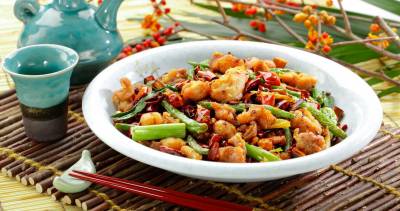Super Hiro's arrives in Kitsilano with West Coast tales of omakase
A story isn’t only told with words or pictures. It can also be told through means such as dance, music, or—perhaps one of the most overlooked ways—food. Granted, the storyline may not have a discernible plot. And it may be far more abstract, or even unconscious. But it’s a story nonetheless, and can be read and enjoyed as such.
In that respect, a new storyteller has begun regaling locals with his own tales.
Super Hiro’s opened on December 4 in Kitsilano at 2585 West Broadway, taking over the location from Thai Cuisine by Montri. The 46-seat, 1,400-square-foot space is tidily adorned. Neither stuffy and fussy nor overly casual, the urbane simplicity of the room brings to mind the Muji philosophy: “This will do”—and appropriately so, as it places the food centre stage.
It’s an omakase restaurant, a Japanese expression for how a diner entrusts the expertise of the chef to create a multi-course meal. It runs counter to the dominant Starbucksization of customizing everything to patron preferences. Such pandering can run to the point of self-indulgence and excessive control that precludes new gustatory experiences.
Most Vancouverites came to know omakase through celebrated chef Hidekazu Tojo, and now his nephew, Hiroki Watanabe, has launched a new chapter in this culinary tradition. Departing from the formal set menu of the traditional haute cuisine kaiseki that Watanabe trained in back in Japan, Watanabe’s omakase menu incorporates inventiveness and culinary poetics that recast B.C. from a distinctly Japanese point of view.
Attracted by the majesty of the Rocky Mountains (and how they surpass the height of Mount Fuji) and Canada’s sprawling natural settings, Watanabe, who hails from Nagoya in Aichi prefecture, came to Vancouver in 2000 to train with his uncle.
In an interview at his new premises, he says, with a chuckle, that he compares himself to Indiana Jones. To wit: when faced with a challenge, he says, “I like to climb it, I wanna see it”. And if there’s an accident, he says he “has to fix it”. It’s this “samurai spirit”, as he calls it, that fuels his inventive cooking style, in which adventurousness is tempered by respect for others.
And then there’s that comical restaurant name. As wordplay on superheroes, it also conveys a playfulness, as play is essential to creativity. He also likes the humorous contrast and element of surprise between the casual name and high-quality cuisine. But basic pragmatism also plays a role: “Most people forget my name but never forget Super Hiro’s.”
There may only be one menu but it changes every day. It’s $100 per person for five-course meal, but for the moment, the restaurant is offering a $60-per-person, three-course meal as an introductory offer.
When Watanabe leads the Georgia Straight through a five-course menu of the day, it unfolds like a collection of short stories.
A ceviche-inspired rock cod dish with Asian pear and kiwi sauce starts off on an ethereal note. The delicate interplay of citrus and light fish flavours conjure an airy, springtime sentiment.
A lightly deep-fried Thai snapper wrapped in zucchini strips with brie cheese and a sweet soy sauce follows. A soft bed of greens offsets the crispiness of the tempura, the combination invoking the salty ocean air in early summer.
Things transition to an autumnal earthiness with Albertan beef, accompanied by a mix of four types of mushrooms (white and brown shimeji, maitake, chanterelle). A gravy-like saikyo miso sauce approximates the comfort of stew on a cold day.
Next up, a dish of baked fish with soy sauce and ginger, alongside shiitake, asparagus, Chinese greens, and marinated carrots, summarizes the elements and seasons of the previous offerings. It's an appropriate prelude to the finale.
And there it is: a colorful plate of sashimi embodies the vibrancy of weeklong Shogatsu festivities, or Japanese New Year. Watanabe accords appropriate respect upon each item, employing wasabi from Shizuoka (which is slightly sweeter than other varieties) and an intriguing selection of seven fish, spanning hobo to sea bass and triggerfish, with uni (sea urchin) also among them.
For a suitable epilogue, a honey-flavoured panna cota with golden kiwi arrives. It’s wonderfully light with, in the tradition of many Asian desserts, nuanced sweetness.
When asked what inspires his creations, he cites the multicultural nature of Vancouver, which he studied from Tojo’s clientele.
But what also spurs his imagination is muda, a Japanese concept that has arisen to address wastefulness. He explains that in the past, chefs would only use part of a tuna, but due to declining resources, they are now learning to use all parts. Such inventiveness requires ingenuity, creativity, and a break with customs, which can sometimes be difficult to balance with Japanese traditions.
However, he points out that as he can tell the difference between the taste of wild and farmed fish, he’s intent on ensuring that the next generation has the opportunity to know the “real flavour” of tuna, snapper, or yellowtail. Consequently, his ingredients are locally sourced as much as possible, and he calls being ecofriendly “my destiny”.
His quest to help preserve nature for future diners requires nothing less than a superheroic commitment and it’s certainly an epic worth following.





















Comments